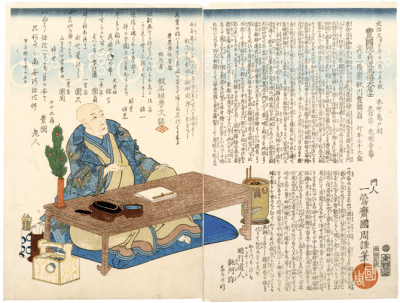Art of Japan and the Death Prints of Shini-e
Lee Jay Walker
Modern Tokyo Times

The world of ukiyo-e in Japan also covered the world of death by mainly commemorating artists, kabuki actors, and musicians through the medium of art. True to nature, farewell poems were included along with posthumous names linking the individual with the next world. Therefore, just like artistic fields and the power of acting influenced individuals in life, the same impact was added in death.
“Death pictures” or “death portraits” is more correctly called Shini-e. These prints of a memorial in the world of shini-e enabled artists to pay homage to former teachers or colleagues held in high regard. Equally, artists from many spectrums commemorated kabuki actors and musicians, for example, through the medium of shini-e.
Ukiyo-e style art based on Japanese woodblock prints and paintings became extremely popular throughout the Edo Period (1603-1867). Indeed, despite the onset of modernity with the Meiji Restoration of 1868, this art form continued during the Meiji Period of Japanese history. However, new art forms influenced by Western art, the role of photography, journalism, and other areas related to technological changes, meant the eventual decline of ukiyo-e was imminent. In saying this, later artistic genres, notably shin-hanga, would continue to link the past by fusing it with modern ideas that related to the changing influences of art forms entering Japan.

The posthumous Buddhist name was given to individuals after death had an ironic link to certain aspects of Japanese art in bygone days. After all, the artists of many original names of art pieces were never fully known based on students paying homage to masters by assigning art in respect. Of course, the reasons are very different – and the same applies to ukiyo-e artists changing their names for various reasons – for example, Ando Hiroshige had several names throughout his life.
Indeed, the poem by Hiroshige before his death and the shini-e of this esteemed artist by the famous artist Kunisada says much about this aspect of Japanese culture. Hence, Hiroshige wrote a beautiful poem just before he left this world. He wrote:
“I leave my brush in the East
And set forth on my journey.
I shall see the famous places in the Western Land.”

Of course, in Buddhism, the “Western Land” for Hiroshige refers to Amida Buddha and paradise in a Japanese context. Yet, this amazing artist knew the meaning had a “double duty.” This applies to an area known by the name of Tōkaidō that exists between the rich cultural city of Kyoto and the powerhouse of Edo (Tokyo).
In a similar light, kabuki actors would write farewell poems and this would be followed by memorial portraits. Overall, shini-e was a natural way to pay homage to individuals of influence in areas already mentioned.

Modern Tokyo News is part of the Modern Tokyo Times group
DONATIONS to SUPPORT MODERN TOKYO TIMES – please pay PayPal and DONATE to sawakoart@gmail.com
http://moderntokyotimes.com Modern Tokyo Times – International News and Japan News
http://sawakoart.com – Sawako Utsumi personal website and Modern Tokyo Times artist
https://moderntokyonews.com Modern Tokyo News – Tokyo News and International News
http://global-security-news.com Global Security News – Geopolitics and Terrorism
PLEASE JOIN ON TWITTER
https://twitter.com/MTT_News Modern Tokyo Times
PLEASE JOIN ON FACEBOOK